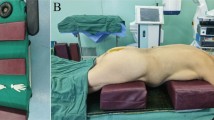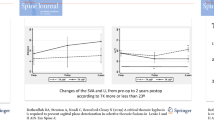Abstract
Purpose
Surgical indications for thoraco-lumbar fractures are driven both by neurological status, fractures instability and kyphotic deformity. Regarding kyphotic deformity, an angulation superior to 20° is considered by many surgeons as a surgical indication to reduce the disability induced by post-traumatic kyphosis. However, there is a lack of data reporting the ideal or theoretical lordosis that one must have in a particular lumbar segment on CT-scan. The main goal of this study was to determine the mean value for segmental lumbar lordosis according to pelvic incidence (PI) on a cohort of normal subjects.
Methods
The consecutive CT-scan of 171 normal adult subjects were retrospectively analyzed. The PI and the segmental lordosis (L4S1, L3L5, L2L4, L3L1, L2T12 and T11-L1) were measured on all CT-scan. The mean values were calculated for the global cohort and a sub-group analysis according to IP ranges (< 45°, 45 < IP < 60° and > 60°) was performed.
Results
The mean angular values for the whole cohort were IP: 54, 9°; L4S1: − 38, 1°; L3L5: − 30, 6°; L2L4: − 14, 1°; L1L3: − 4, 9°; T12L2: + 1, 9° and T11L1: + 5, 4°. The segmental values vary significatively with PI ranges, as for L3L5: − 26, 8° (PI < 45°); − 30° (45 < PI < 60°) and − 35, 1° (PI > 60°).
Conclusion
These results provide a referential of theoretical values of segmental lordosis according to PI. This abacus may help spinal surgeon in their decision-making process regarding lumbar fractures, to determine the amount of sagittal correction needed, according to the PI range, to be adapted to the sagittal morphology of the patient.
Level of evidence
III.


Similar content being viewed by others
Data availability
The anonymous data are available from the corresponding authors at the editor request.
References
Oner C, Rajasekaran S, Chapman JR et al (2017) Spine trauma-what are the current controversies? J Orthop Trauma. https://doi.org/10.1097/BOT.0000000000000950
Li S, Li Z, Hua W et al (2017) Clinical outcome and surgical strategies for late post-traumatic kyphosis after failed thoracolumbar fracture operation: case report and literature review. Medicine (United States). https://doi.org/10.1097/MD.0000000000008770
Hu W, Wang B, Run H et al (2016) Pedicle subtraction osteotomy and disc resection with cage placement in post-traumatic thoracolumbar kyphosis, a retrospective study. J Orthop Surg Res 11:112. https://doi.org/10.1186/s13018-016-0447-1
Hashimura T, Onishi E, Ota S et al (2023) Correction loss following short-segment posterior fixation for traumatic thoracolumbar burst fractures related to endplate and intervertebral disc destruction. BMC Musculoskelet Disord 24:174. https://doi.org/10.1186/s12891-023-06288-y
Lainé G, Mezjan I, Masson D et al (2023) Risk factors for kyphosis recurrence after implant removal in percutaneous osteosynthesis for post-traumatic thoracolumbar fracture. Eur Spine J. https://doi.org/10.1007/s00586-023-07895-y
Guigui P, Levassor N, Rillardon L et al (2003) Physiological value of pelvic and spinal parameters of sagital balance: analysis of 250 healthy volunteers. Rev Chir Orthop Reparatrice Appar Mot 89(6):496–506
Scheer JK, Lafage R, Schwab FJ et al (2018) Under correction of sagittal deformities based on age-adjusted alignment thresholds leads to worse health-related quality of life whereas over correction provides no additional benefit. Spine (Phila Pa 1976). https://doi.org/10.1097/BRS.0000000000002435
Mayer M, Ortmaier R, Koller H et al (2017) Impact of sagittal balance on clinical outcomes in surgically treated T12 and L1 burst fractures: analysis of long-term outcomes after posterior-only and combined posteroanterior treatment. Biomed Res Int. https://doi.org/10.1155/2017/1568258
Le Huec JC, Thompson W, Mohsinaly Y et al (2019) Sagittal balance of the spine. Eur Spine J 28:1889–1905. https://doi.org/10.1007/s00586-019-06083-1
Hallager DW, Hansen LV, Dragsted CR et al (2016) A comprehensive analysis of the SRS-Schwab adult spinal deformity classification and confounding variables. Spine (Phila Pa 1976). https://doi.org/10.1097/brs.0000000000001355
Reinhold M, Knop C, Beisse R et al (2010) Operative treatment of 733 patients with acute thoracolumbar spinal injuries: comprehensive results from the second, prospective, internet-based multicenter study of the spine study group of the German association of trauma surgery. Eur Spine J. https://doi.org/10.1007/s00586-010-1451-5
Laouissat F, Sebaaly A, Gehrchen M, Roussouly P (2018) Classification of normal sagittal spine alignment: refounding the Roussouly classification. Eur Spine J. https://doi.org/10.1007/s00586-017-5111-x
Celestre PC, Dimar JR, Glassman SD (2018) Spinopelvic parameters: lumbar lordosis, pelvic incidence, pelvic tilt, and sacral slope: what does a spine surgeon need to know to plan a lumbar deformity correction? Neurosurg Clin N Am. https://doi.org/10.1016/j.nec.2018.03.003
Hyun SJ, Han S, Kim YB et al (2019) Predictive formula of ideal lumbar lordosis and lower lumbar lordosis determined by individual pelvic incidence in asymptomatic elderly population. Eur Spine J. https://doi.org/10.1007/s00586-019-05955-w
Baker JF, Don AS, Robertson PA (2020) Pelvic incidence: computed tomography study evaluating correlation with sagittal sacropelvic parameters. Clin Anat. https://doi.org/10.1002/ca.23478
Lee CM, Liu RW (2022) Comparison of pelvic incidence measurement using lateral x-ray, standard ct versus ct with 3d reconstruction. Eur Spine J. https://doi.org/10.1007/s00586-021-07024-7
Pesenti S, Lafage R, Stein D et al (2018) The amount of proximal lumbar lordosis is related to pelvic incidence. Clin Orthop Relat Res. https://doi.org/10.1097/CORR.0000000000000380
Roscop C, Mathio P, Gajny L et al (2021) Analysis of apex and transitional vertebra of the spine according to pelvic incidence using orientation and position parameters. Eur Spine J. https://doi.org/10.1007/s00586-021-06908-y
Ulmar B, Brunner A, Gühring M et al (2010) Inter- and intraobserver reliability of the vertebral, local and segmental kyphosis in 120 traumatic lumbar and thoracic burst fractures: evaluation in lateral X-rays and sagittal computed tomographies. Eur Spine J. https://doi.org/10.1007/s00586-009-1231-2
Munting E (2010) Surgical treatment of post-traumatic kyphosis in the thoracolumbar spine: indications and technical aspects. Eur Spine J. https://doi.org/10.1007/s00586-009-1117-3
Lafage R, Schwab F, Challier V et al (2016) Defining spino-pelvic alignment thresholds should operative goals in adult spinal deformity surgery account for age? Spine. https://doi.org/10.1097/BRS.0000000000001171
Alzakri A, Boissière L, Cawley DT et al (2018) L5 pedicle subtraction osteotomy: indication, surgical technique and specificities. Eur Spine J. https://doi.org/10.1007/s00586-017-5403-1
Barut N, Marie-Hardy L, Bonaccorsi R et al (2019) Immediate and late discal lesions on MRI in Magerl A thoracolumbar fracture: analysis of 76 cases. Orthop Traumatol Surg Res. https://doi.org/10.1016/j.otsr.2019.03.008
Lu X, Zhu Z, Pan J et al (2022) Traumatic vertebra and endplate fractures promote adjacent disc degeneration: evidence from a clinical MR follow-up study. Skeletal Radiol 51:1017–1026. https://doi.org/10.1007/s00256-021-03846-0
Chevillotte T, Coudert P, Cawley D et al (2018) Influence of posture on relationships between pelvic parameters and lumbar lordosis: comparison of the standing, seated, and supine positions. A preliminary study. Orthop Traumatol Surg Res 104:565–568. https://doi.org/10.1016/j.otsr.2018.06.005
Jing Z, Dong J, Li Z, Nan F (2018) Single balloon versus double balloon bipedicular kyphoplasty: a systematic review and meta-analysis. Eur Spine J 27:2550–2564. https://doi.org/10.1007/s00586-018-5631-z
Author information
Authors and Affiliations
Corresponding author
Ethics declarations
Conflict of interest
The authors declare that they have no known competing financial interests or personal relationships that could have appeared to influence the work reported in this paper.
Ethical approval
This study received IRB approval, under the number: 20220630143858. This study has been performed in accordance with the ethical standards in the 1964 Declaration of Helsinki.
Additional information
Publisher's Note
Springer Nature remains neutral with regard to jurisdictional claims in published maps and institutional affiliations.
Supplementary Information
Below is the link to the electronic supplementary material.
Rights and permissions
Springer Nature or its licensor (e.g. a society or other partner) holds exclusive rights to this article under a publishing agreement with the author(s) or other rightsholder(s); author self-archiving of the accepted manuscript version of this article is solely governed by the terms of such publishing agreement and applicable law.
About this article
Cite this article
Marie-Hardy, L., Mohsinaly, Y., Pietton, R. et al. Defining threshold for sagittal correction in lumbar fractures. Eur Spine J 33, 1550–1555 (2024). https://doi.org/10.1007/s00586-024-08138-4
Received:
Revised:
Accepted:
Published:
Issue Date:
DOI: https://doi.org/10.1007/s00586-024-08138-4




